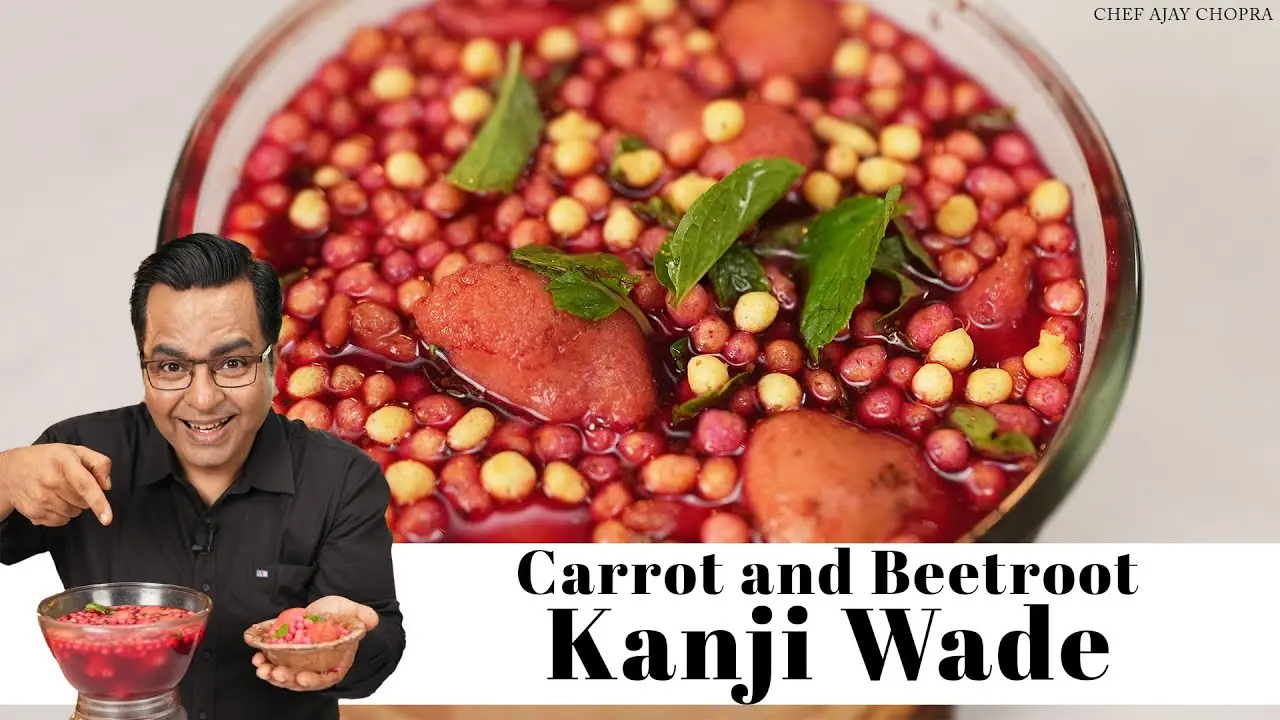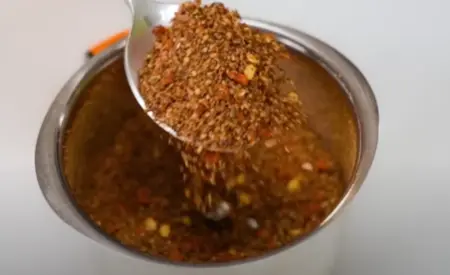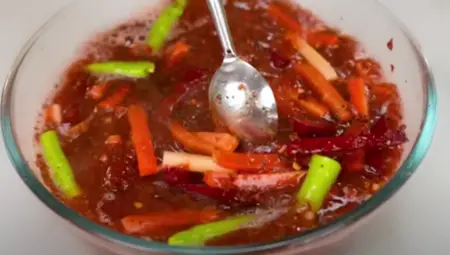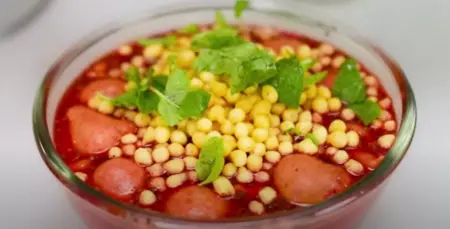
Carrot & Beetroot Kanji Wade Recipe

40 Mins

7-8 People

05 Mins
Introduction
Hey, foodies! My name is Ajay Chopra and I am excited to share with you a delicious recipe for Carrot & Beetroot Kanji Wade that will take you right to the heart of Punjab.
Growing up, my grandmother's recipes like Amritsari Chole and Dal Makhani were always a highlight of family gatherings. Today, I'm thrilled to share another cherished recipe that brings back fond memories of my childhood.
Now let us bring those old-fashioned tastes back to life in your home!
Ingredients of Kanji Vada
For Kanji Masala:
- 3 Dry red chillies
- 3 tbsp Yellow mustard seeds
- 2 tbsp Black mustard seeds
- 1 tsp Ajwain (carom seeds)
- 1 tsp Black pepper
- ½ tbsp Jeera (cumin seeds)
For Kanji:
- 4 Carrots
- 1 Beetroot
- 1 tbsp Black salt
- 1 tbsp Hing (asafoetida)
- 4 tbsp Kanji masala (from above)
- 3-4 Green chillies
For Vada:
- 1 cup Yellow moong dal, soaked
- ½ cup Urad dal, soaked
- 1 tsp Hing
- 2 Green chillies
- 1 inch Ginger
- 1 tsp Salt
- 1 tsp Jeera
- 1 tsp Black pepper
- Oil for deep frying
- 4 cups Water
- 1 tsp Salt
- ½ tsp Hing
For Serving:
- ½ cup Boondi
- ¼ cup Mint leaves
Instructions of Kanji Vada
Prepare Kanji Masala:
-
Dry Roast Spices:
Heat a pan over medium heat. Add dry red chillies, yellow mustard seeds, black mustard seeds, ajwain, black pepper, and jeera to the pan. Dry roast the spices until aromatic and slightly darkened, being careful not to burn them. -
Grind the Masala:
Transfer the roasted spices to a mixer jar or spice grinder. Grind into a fine powder to create your kanji masala. Store the masala in an airtight container for later use. -

Prepare Kanji:
-
Prep Vegetables:
Wash and peel the carrots and beetroot, then cut them into thick batons or strips. -
Mix and Ferment:
In a mixing bowl, combine the carrot batons, beetroot batons, kanji masala, black salt, hing, and chopped green chillies. Mix well and transfer into a clean glass jar. Pour the hot water into the jar until the mixture is submerged by 1-2 inches. Let it cool to room temperature, cover with a muslin cloth, and secure with a rubber band. Place the jar in a sunny spot for fermentation for at least 3 days, stirring daily. -

Prepare Vada:
-
Grind Dal:
Grind soaked yellow moong dal, soaked urad dal, ginger, green chillies, hing, salt, jeera, and black pepper into a smooth paste. -
Aerate Batter:
Transfer the mixture to a bowl and whisk vigorously to aerate. -
Fry Vadas:
Heat oil in a deep frying pan. Drop small portions of the vada batter into the hot oil and fry until golden brown. Remove from oil, drain excess oil, and soak in salted water for 4-5 minutes. -

Assemble Kanji Vada:
- Combine and Serve:
In a serving bowl, combine kanji liquid, boondi, and mint leaves. Squeeze excess water from soaked vadas and add to the kanji mixture. Mix well to coat the vadas with kanji. Serve and enjoy this refreshing and tangy snack. 
About the Recipe
Carrot & Beetroot Kanji Wade is a classic Punjabi treat that has the health benefits of fermented vegetables and the crunch of wades. This cool drink is not only delicious, but it is also good for you in important ways. Fermented foods like Carrot & Beetroot Kanji Wade offer numerous health benefits, including improved gut health. According to Harvard Health Publishing, fermented foods contain beneficial probiotics that support digestion and overall well-being. Carrots and beets together also give you a lot of vitamins and antioxidants, which are great for making your defence system stronger.
Cooking Tips
- Choose Fresh Ingredients: Choose fresh carrots and beets for the most flavour and health benefits.
- Proper Fermentation: For the Kanji to get its unique sour taste, leave it to ferment in the sun for at least three days.
- Balancing Spices: Change the amounts of spices to suit your taste. Some people like it really spicy, while others like it not as hot.
- Consistency of Batter: Add water slowly to the batter until it gets thick enough to pour, then you will have the right consistency for your wades.
- Crispy Wades: Fry the wades in hot oil until the outside is golden brown and crispy. Make sure that all sides are cooked the same way.
Pairing Guide
Beetroot and carrot Kanji Wade goes really well with many different kinds of food, making their flavours stronger and giving your meal a new, refreshing twist. For the perfect match, here are some ideas:
- Punjabi Thali: For a real taste of Punjabi food, serve with traditional dishes like Makki di Roti and Sarson da Saag.
- Street Food Platter: Pair with spicy street foods like Samosas, Pakoras, and Chaat for a delicious contrast of flavors.
- Light Salads: Enjoy with fresh salads to add a tangy kick, complementing the crispiness of the wades perfectly.
- Refreshing Beverages: Serve alongside chilled beverages like Lassi or Jaljeera to quench your thirst and cleanse your palate between bites.
10 Frequently Asked Questions about Carrot & Beetroot Kanji Wade
-
What is Kanji Wade?
- Kanji Wade is a traditional North Indian drink made from fermented carrots and beetroots, served with crispy lentil fritters called wades.
-
How long does it take to ferment Kanji?
- Kanji typically takes around three to four days to ferment properly, depending on the temperature and sunlight exposure.
-
Can I adjust the spice level in Kanji?
- Yes, you can adjust the spice level by adding more or less red chili powder according to your taste preferences.
-
Are there any health benefits to consuming Kanji?
- Yes, Kanji is rich in probiotics, which are beneficial for gut health and digestion. It also provides essential vitamins and antioxidants from the fermented vegetables.
-
Can I store Kanji for a long time?
- Kanji can be stored in airtight containers in the refrigerator for up to a week. However, its flavor may continue to develop over time.
-
Is Kanji Wade a summer drink?
- While Kanji Wade is traditionally enjoyed during the summer months for its refreshing and cooling properties, it can be enjoyed year-round as a healthy beverage.
-
Can I make Kanji without fermenting it?
- While traditional Kanji requires fermentation for its characteristic flavor, you can make a quick version by skipping the fermentation step. However, it will lack the tanginess of fermented Kanji.
-
What are the main ingredients in Kanji Wade?
- The main ingredients in Kanji Wade include carrots, beetroots, mustard seeds, red chili powder, and black salt, along with crispy wades made from lentil batter.
-
Can I use different vegetables in Kanji?
- Yes, you can experiment with different vegetables like radishes, turnips, or even mangoes to create unique variations of Kanji according to your taste preferences.
-
Is Kanji Wade gluten-free?
- Yes, Kanji Wade is gluten-free as it is made from fermented vegetables and lentil batter, making it suitable for individuals with gluten intolerance or celiac disease.
